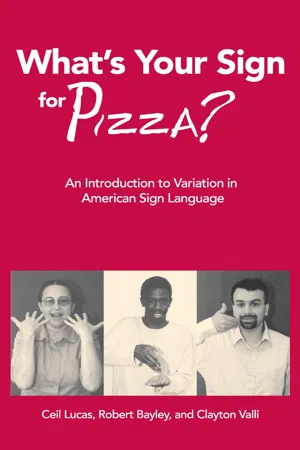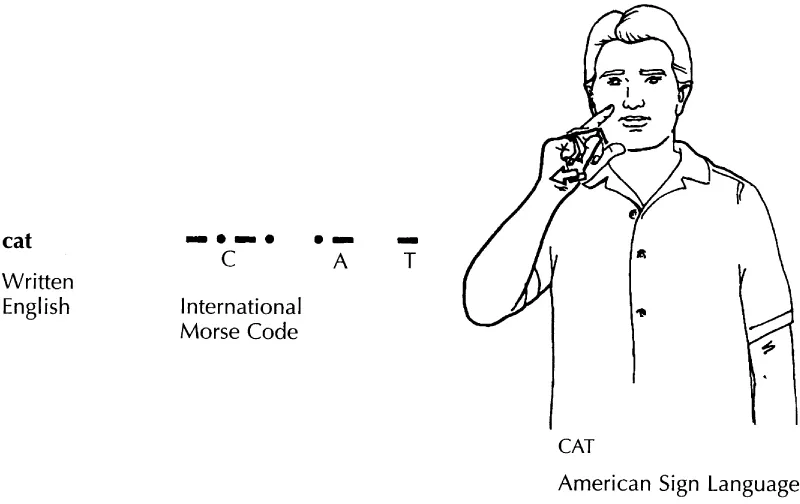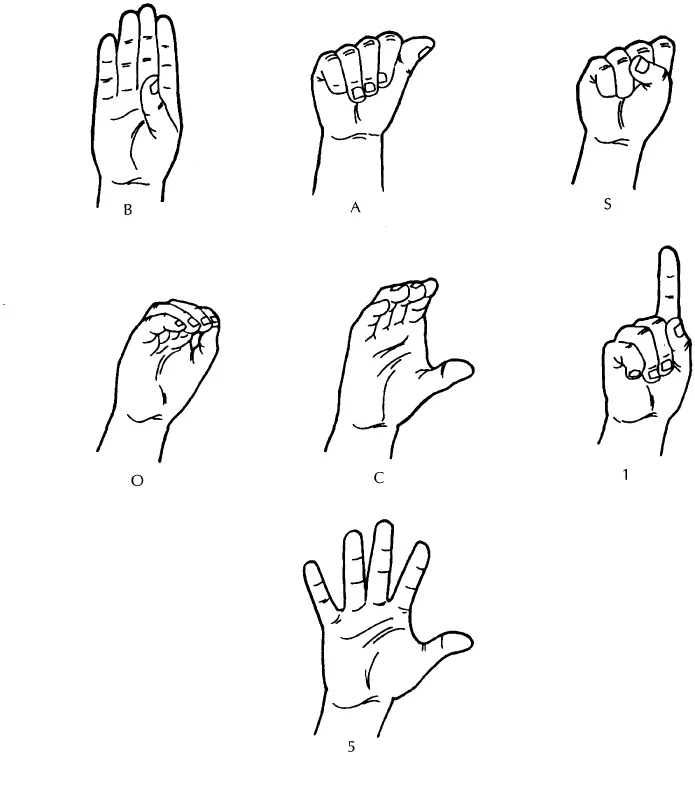
eBook - ePub
What's Your Sign for Pizza?
An Introduction to Variation in American Sign Language
- English
- ePUB (mobile friendly)
- Available on iOS & Android
eBook - ePub
What's Your Sign for Pizza?
An Introduction to Variation in American Sign Language
About this book
This introductory text celebrates another dimension of diversity in the United States Deaf community — variation in the way American Sign Language (ASL) is used by Deaf people all across the nation. The different ways people have of saying or signing the same thing defines variation in language. In spoken English, some people say "soda," others say "pop," "Coke," or "soft drink;" in ASL, there are many signs for "birthday," "Halloween," "early," and of course, "pizza."
What's Your Sign for Pizza? derives from an extensive seven-year research project in which more than 200 Deaf ASL users representing different ages, genders, and ethnic groups from seven different regions were filmed sharing their signs for everyday vocabulary. The film clips form a supplemental resource to the text and are referenced in their relevant chapters. The text begins with an explanation of the basic concepts of language and the structure of sign language. Each part of the text concludes with questions for discussion, and the final section offers three supplemental readings that provide further information on variation in both spoken and signed languages. What's Your Sign for Pizza also briefly sketches the development of ASL, which explains the relationships between language varieties throughout the country.
The videos are available online at www.youtube.com/GallaudetUniversityPress.
What's Your Sign for Pizza? derives from an extensive seven-year research project in which more than 200 Deaf ASL users representing different ages, genders, and ethnic groups from seven different regions were filmed sharing their signs for everyday vocabulary. The film clips form a supplemental resource to the text and are referenced in their relevant chapters. The text begins with an explanation of the basic concepts of language and the structure of sign language. Each part of the text concludes with questions for discussion, and the final section offers three supplemental readings that provide further information on variation in both spoken and signed languages. What's Your Sign for Pizza also briefly sketches the development of ASL, which explains the relationships between language varieties throughout the country.
The videos are available online at www.youtube.com/GallaudetUniversityPress.
Frequently asked questions
Yes, you can cancel anytime from the Subscription tab in your account settings on the Perlego website. Your subscription will stay active until the end of your current billing period. Learn how to cancel your subscription.
No, books cannot be downloaded as external files, such as PDFs, for use outside of Perlego. However, you can download books within the Perlego app for offline reading on mobile or tablet. Learn more here.
Perlego offers two plans: Essential and Complete
- Essential is ideal for learners and professionals who enjoy exploring a wide range of subjects. Access the Essential Library with 800,000+ trusted titles and best-sellers across business, personal growth, and the humanities. Includes unlimited reading time and Standard Read Aloud voice.
- Complete: Perfect for advanced learners and researchers needing full, unrestricted access. Unlock 1.4M+ books across hundreds of subjects, including academic and specialized titles. The Complete Plan also includes advanced features like Premium Read Aloud and Research Assistant.
We are an online textbook subscription service, where you can get access to an entire online library for less than the price of a single book per month. With over 1 million books across 1000+ topics, we’ve got you covered! Learn more here.
Look out for the read-aloud symbol on your next book to see if you can listen to it. The read-aloud tool reads text aloud for you, highlighting the text as it is being read. You can pause it, speed it up and slow it down. Learn more here.
Yes! You can use the Perlego app on both iOS or Android devices to read anytime, anywhere — even offline. Perfect for commutes or when you’re on the go.
Please note we cannot support devices running on iOS 13 and Android 7 or earlier. Learn more about using the app.
Please note we cannot support devices running on iOS 13 and Android 7 or earlier. Learn more about using the app.
Yes, you can access What's Your Sign for Pizza? by Ceil Lucas,Robert Bayley,Clayton Valli in PDF and/or ePUB format, as well as other popular books in Langues et linguistique & Linguistique. We have over one million books available in our catalogue for you to explore.
Information
1
Some Basic Concepts about Language
Before we present differences in the ways that Deaf people in various regions of the United States sign and how the same person may use different forms of a sign on different occasions, we need to describe some of the distinctive features of all human languages, including of course ASL and other signed languages, and to distinguish between human languages and other types of communication systems. We also briefly sketch the history of ASL to show the relationships between the language varieties found throughout the United States. As we shall see, one of the distinguishing features of all human languages is that languages, in contrast to other communication systems with which they share some characteristics, are always changing. And we shall also see that one of the main distinguishing features of human languages is that they vary. That is, people have different ways of signing or saying the same thing.

Clip 1 . The concepts discussed here are also covered in the Basic Concepts section of the video.

LANGUAGE IS A COMMUNICATION SYSTEM
Language is a rule-governed communication system.2 A communication system is a system that people use to share information. When a system is based on rules that its users know and follow, it is called a rule-governed system. Examples of other communication systems include Morse code, which uses either sound or light, semaphore (the flag system the U.S. Navy uses), traffic signals, and signs on highways and in public places. Many animals such as birds, bees, and dolphins also have communication systems.
Language has much in common with all of these systems. For example, all of these systems are composed of symbols. The combinations of dots and dashes in Morse code, for example, are symbols for English letters. The signs that we see on highways and in public places are also symbols. Spoken English words are symbols made up of a combination of sounds, and English letters are written symbols for sounds. And ASL signs are symbols (see Figure 1).

Figure 1. Symbolic representation of “cat.” Note: This is one of several variants of the sign CAT.
These symbols are organized and used systematically. For example, in ASL, when a sign is made with two hands and the two handshapes are different, only one hand, referred to as the dominant hand, can move. We see this in the signs MONEY and WORD. (Note the convention of writing the English words for signs in small capital letters.) In MONEY, the hand that moves is shaped like a Flat O, and the nondominant hand is shaped like an Open B. Only the Flat O handshape moves. In WORD, the dominant hand is shaped like a G, while the nondominant hand is shaped like a 1. Only the G moves. The nondominant hand in two-handed signs tends to be one of seven handshapes: B, A, S, O, C, 1, and 5 (see Figure 2).

Figure 2. The seven basic handshapes of the passive hand
The forms of the symbols that make up a communication system may be arbitrary or iconic. Arbitrary means that the actual form of the symbol does not reflect the form of the thing or activity that it symbolizes. The form of the ASL sign WRONG is arbitrary, and the spoken form of the English word door is also arbitrary. Iconic means that the form of the symbol is an icon or picture of some aspect of the thing or activity it symbolizes. The forms of the ASL signs TREE, TABLE, and many others are iconic. In spoken English, words such as choo-choo, meow, and cock-a-doodle-doo are iconic.
The symbols of a communication system are shared by members of a community. Users of ASL form a community, and they share a system that is different from the one shared by users of British Sign Language (BSL) or Australian Sign Language (AUSLAN). There may also be smaller communities within the larger community, thus signers from California may use signs that signers from Connecticut do not know or use; moreover, as we will see, African American signers may use signs that white signers do not use.
LANGUAGE HAS SOME UNIQUE CHARACTERISTICS
Language has some characteristics that make it unique. For example, language is productive, whereas other communication systems are limited in the number of messages they can produce. The number of sentences and messages that can be produced with the symbols of human language is infinite. It is impossible to even try to count how many sentences can be produced in a given language. Every day you see sentences that you have never seen before, and you produce sentences that have never been produced before.
Language is composed of symbols and has ways of showing the relationship between symbols. For example, English has a class of words called prepositions that shows the relationship between other words. In the sentence “The book is on the table,” the word “on” shows the relationship between the words “book” and “table.” This relationship is shown in ASL with classifier predicates, so a signer might sign BOOK and TABLE and then use a handshape and a movement that represents the placing of the book on the table.
Although the set of symbols that other communication systems use is limited and set, language permits the continual introduction of new symbols. New symbols are often introduced into ASL by means of fingerspelling. Recent examples of this are #FAX and #EMAIL (of course, the English words themselves are also fairly new). Two signs that already exist can also be combined to create a new sign in a process known as compounding. Older examples of compounds in ASL are EAT⁀SLEEP (“home”) and BOY⁀SAME (“brother”); a fairly recent addition is DEAF⁀ WAY.* New signs are also added to the language as a result of ontact with other languages. Many American signs for countries are now being abandoned in favor of the country’s own sign, as we see with the sign for ITALY (see Figure 3).

Figure 3. The ASL and Italian Sign Language signs for ITALY
* The # symbol is used to show the difference between a fingerspelled loan sign and a regular sign. A loan sign is a combination of signs for English letters and ASL movements. The ⁀ symbol indicates that the two signs make up a compound sign.
Users of other communication systems generally use their systems to communicate about essential survival or emergency management, but language can be used for an unrestricted number of domains. That is, language can be used to talk about any topic, from survival and emergencies to philosophy, physics, and art. The symbols that make up a language can be broken down into smaller parts, and sometimes these smaller parts have independent meanings. For example, one part of each sign is its handshape. The signs LOUSY and AWKWARD have a 3 handshape, while the sign PREACH has a 9 or F handshape. In these signs the handshape itself has no specific meaning. But in the signs for THREE-MONTHS, THREE-DOLLARS, and NINE-WEEKS, these same handshapes have the specific meaning of a number.
In other communication systems, each symbol or group of symbols usually has one meaning. In language, a symbol or a group of symbols may convey more than one meaning. For example, the sequence of signs HOME YOU may have different meanings depending on the facial expression of the signer and the situation in which the signs are produced. It may be a yes/no question (“Are you home?”) or a statement (“You’re home.”) or even a command (“Go home!”). Users of a language can refer to the past, future, and nonimmediate, unlike other communication systems, which are generally restricted to the present or immediate.
Language naturally changes across time, unlike other communication systems. We see, for example, that some two-handed signs such as COW have become one handed; the active hand of the sign HELP used to be placed on the elbow but now has moved up to the base hand; the base handshape in one form of TOMATO has changed from a Flat O to a 1 handshape. These changes, moreover, do not happen all at once. Rather, for a long time, two (or more) signs may be used in a community, with younger members using more of the new signs than older members. In many cases the change from one sign to another (or from one form of a sign to another) takes many years. This type of change is characteristic of every living language.
Just as language varies over time, it also varies across geographical and social space. People in Boston, for example, may sign differently from the way that people in New Orleans do, and people in California may use signs (or forms of signs) that are different from those that people in Washington, D.C., use. Regional differences are not the only influences that show themselves in different ways of signing (or of speaking). Social influences also play major roles in signers’ choices between different signs or versions of the same sign. For example, in most languages that linguists have studied carefully, women and men sign or speak differently. Older people use signs that are different from the ones younger people use, and members of different ethnic groups sometimes prefer different signs or forms of signs.
Another difference between a language and other communication systems occurs in the range of styles, or registers, that characterize all human languages. In written English, for example, when we are writing a letter to apply for a job we choose words and use conventions that are different from the ones we use when we’re writing a letter or an email to a close friend. And, in ASL and other sign languages, when we are at home relaxing with friends and family we express ourselves differently from the way we do when we are meeting with our supervisor at work.
In contrast to other communication systems, language can be used interchangeably. All users of a language can send and receive messages. This is not true, though, of animal communication systems. For example, only male birds sing, and only foraging bees, the ones who hunt for food, dance.
Language users also monitor their use—that i...
Table of contents
- Cover
- Half Title
- Title Page
- Copyright Page
- Dedication
- Contents
- Preface
- Introduction
- 1. Some Basic Concepts about Language
- 2. Signs Have Parts
- 3. Variation: Basic Concepts
- 4. Phonological Variation
- 5. Syntactic Variation
- 6. Lexical Variation
- 7. Collecting Variable Data
- 8. Summary and Conclusions
- Notes
- Supplementary Readings
- The Importance of Variation Research for Deaf Communities
- Lexical Variation in African American and White Signing
- Sociolinguistic Variation
- Index
- Back Cover